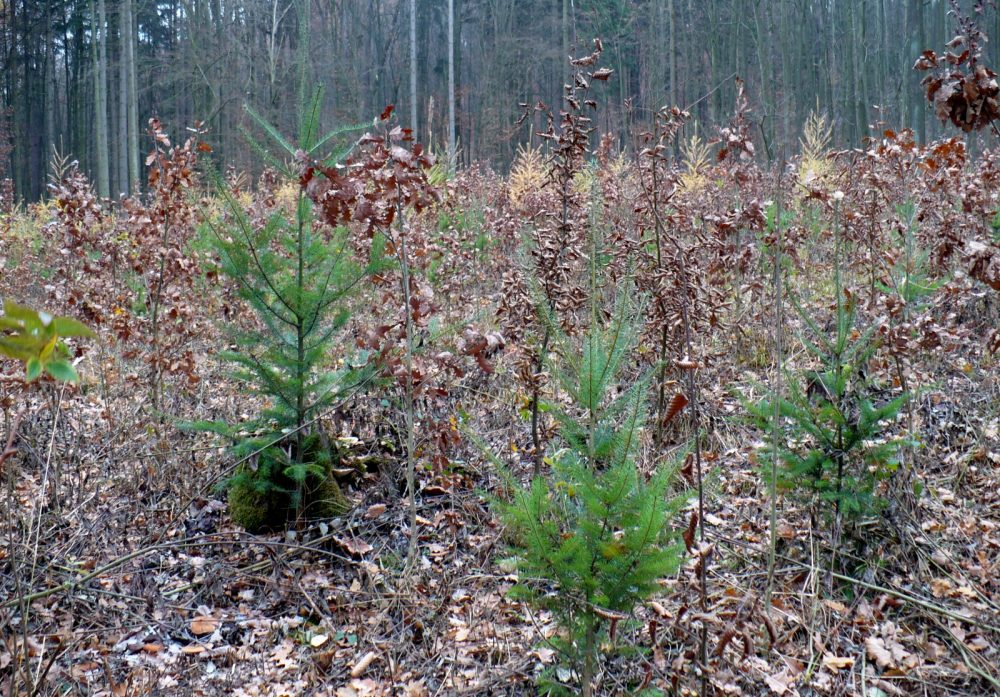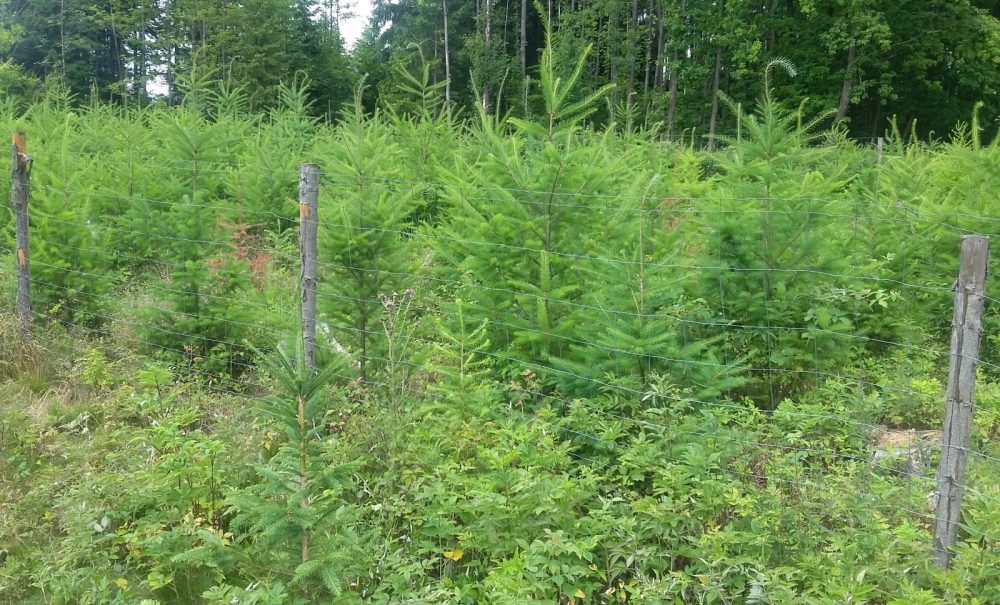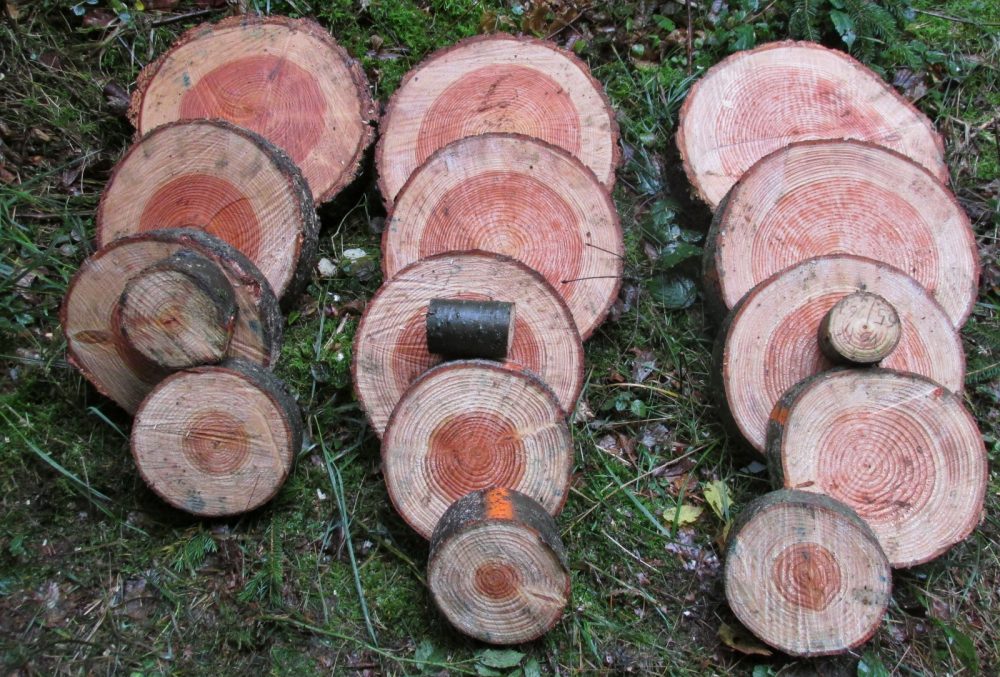Water management of Douglas fir in mixture stands with European beech
Opinions and decisions about the higher Douglas fir composition in our forests as a substitute for declining Norway spruce should be based on information and knowledge about its growth characteristics and site demands, or about the risks associated with its silviculture management. One of the characteristics of growing extraordinary importance is the water regime of Douglas fir and stand mixtures with this tree species, especially in connection to climatic extremes with dangers of floods and drought. Obvious intensive Douglas fir growth is not only due to its intensive use of water, but also of nitrogen.
 As one of the Douglas fir characteristics, it is possible to mention its ability of increased groundwater use in the summer when rainfall is low. Douglas fir is able to draw water from deeper soil layers, much more efficiently than Norway spruce. This allows to this tree species to transport much more water, especially during dry periods, and also ability to grow faster than spruce. These characteristics should be taken into account by foresters when considering the forest tree species composition of future forests, as this tree species can have a significant both forest and hydrological impact. Intensive use of water in the soil by Douglas fir could worse water conditions in river basins with a tight water balance, where water consumption is approximately equal to atmospheric precipitation.
As one of the Douglas fir characteristics, it is possible to mention its ability of increased groundwater use in the summer when rainfall is low. Douglas fir is able to draw water from deeper soil layers, much more efficiently than Norway spruce. This allows to this tree species to transport much more water, especially during dry periods, and also ability to grow faster than spruce. These characteristics should be taken into account by foresters when considering the forest tree species composition of future forests, as this tree species can have a significant both forest and hydrological impact. Intensive use of water in the soil by Douglas fir could worse water conditions in river basins with a tight water balance, where water consumption is approximately equal to atmospheric precipitation.
Scientists from the Forestry and Game Management Research Institute, Research Station Opočno, used to focus on research of Douglas fir in the Czech Republic forests for a long time. Their latest research results were published in the article Dynamika půdní vlhkosti pod mladým douglaskovým porostem s bukem v podhorské oblasti (Dynamics of soil moisture under a young Douglas fir stand with beech in the foothills) in the journal Reports of Forest Research 1/2022.
In 2002, an experimental climate-hydrological trial in the Douglas fir forest stand with beech admixture has been established in the domestic natural and technical-economic conditions of the Orlické Mountains foothills, for the purposes of research. The average precipitation per year is 721 mm there, the average annual air temperature is 8.4 ° C.
The results of the research indicate reaching the limit of moisture availability (11%) in surface soil layers (0–20 and 20–35 cm) in the last four of the five vegetation periods and prolonging the time of reduced moisture availability for the studied stand. Most of the loss of soil moisture is consumed for evapotranspiration (total evaporation) during the vegetation period. The highest values of soil water losses were from the layer of 0–20 cm, while water losses in deeper layers they gradually decreased.
 Douglas fir stand with beech admixture has utilized a layer of soil 20–35 cm (the second most moist soil layer during the monitoring), less utilization was recorded usually in case of a drier layer 0–20 cm (both layers with dense rooting), a little utilization was recorded in layer 35– 50 cm and even less utilization was found in layer of 50-65 cm, which used to be the wettest (both layers with sparse to occasional rooting and high stonyness).
Douglas fir stand with beech admixture has utilized a layer of soil 20–35 cm (the second most moist soil layer during the monitoring), less utilization was recorded usually in case of a drier layer 0–20 cm (both layers with dense rooting), a little utilization was recorded in layer 35– 50 cm and even less utilization was found in layer of 50-65 cm, which used to be the wettest (both layers with sparse to occasional rooting and high stonyness).
In addition to the depth of sampling, moisture losses were also related to the intensity of atmospheric precipitation and air temperature. Precipitation in the open area ranged from 296 to 366 mm (average 338 mm) in the non-vegetation period, and from 242 to 566 mm (average 383 mm) in the vegetation period. In the non-vegetation period, average seasonal temperatures fluctuated from 0.6 to 3.4 ° C (average 2.3 ° C), in the growing season from 13.9 to 15.8 ° C (average 14.5 ° C).
The amount of precipitation coming to the soil surface under Douglas fir stand with beech admixture is very significant for soil moisture. Interception losses (part of the precipitation is captured by vegetation and does not reach the soil surface) affect the effective (vegetation) precipitation for Douglas fir, beech and their mixture. Douglas fir interception represents 30%, beech 16% and their mixtures 19% precipitation in the open area.
 During the summer drought, the water content available to the plants in the upper 0.6 m of soil reaches minimum values and humidification occurs only during autumn and winter. Mature Douglas fir can use the water stored in the trunk during the summer drought. Large seasonal changes in the available water content of the soil do not correspond to the relative water content in the sapwood.
During the summer drought, the water content available to the plants in the upper 0.6 m of soil reaches minimum values and humidification occurs only during autumn and winter. Mature Douglas fir can use the water stored in the trunk during the summer drought. Large seasonal changes in the available water content of the soil do not correspond to the relative water content in the sapwood.
Thus, Douglas fir apparently regulates water loss to maintain a constant ± 10% water content in the strain throughout the year, despite large changes in soil moisture. The sapwood in stem contains a large amount of free water, followed by the stem bast, sapwood in branches, bast in branches and needles.
The uptake of nutrients is closely related to the water content of the soil. Douglas fir is using fine roots in the overlying humus and in the five- to twenty-centimetre layer of mineral soil to absorb nutrients. This fact corresponded to the lowest moisture content of the upper soil layer at 0–20 cm, or up to 35 cm, approaching during the dry summer periods 2015, 2016, 2018 and 2019 the limit of reduced moisture availability for plants (11%). At lower values, photosynthetic activity is already significantly reduced.
 As other subject of research, it was also the effect of tending treatments in which Douglas fir was suppressed and beech released on growth improvement and beech reclamation functions. Douglas fir overgrows beech, during line mixing. To preserve the beech admixture, the Douglas fir needs to be dampened in favour of releasing the beech. Adequate Douglas fir suppression favouring beech will improve both the hydric and amelioration function of the Douglas fir stand with beech admixture.
As other subject of research, it was also the effect of tending treatments in which Douglas fir was suppressed and beech released on growth improvement and beech reclamation functions. Douglas fir overgrows beech, during line mixing. To preserve the beech admixture, the Douglas fir needs to be dampened in favour of releasing the beech. Adequate Douglas fir suppression favouring beech will improve both the hydric and amelioration function of the Douglas fir stand with beech admixture.
The hydrological years 2013/2014 – 2018/2019 were the years of the six-year long dry period 2013/2014 to 2018–2019. In particular, the soil layer 0–20 cm touched or even fell below the limit of reduced moisture availability of 11% (four years out of seven) during the growing seasons; a layer of 20–35 cm was presented in a similar way.
Field water capacity is an important hydrolimite for water regime of Douglas fir stand with beech. If the field capacity for sandy loam soil is characterized by 22.5%, then in the peaks of vegetation seasons all results are below this value. The situation is saved by the non-vegetation period, which can supply Douglas fir water adequately for the beginning of the growing season by storing water in all tree parts, mostly in the stems.
Storing water in Douglas fir helps to overcome the peak of summer with a high total evaporation. The noon closing of stomata also saves water. It can be concluded that these processes simulate the humidity conditions of the Douglas fir in its American homeland. Admixed beech, adequately adapted to the growth of Douglas fir, can also help its water regime by hydraulic redistribution (hydraulic lift) of groundwater.
The article Dynamics of soil moisture under the young Douglas-fir stand with beech in the foothills can be downloaded here.
The article was prepared within the research project NAZV QK1810415 “Impact of tree composition and structure of forest stands on the microclimate and hydrological conditions in the landscape” (Vliv dřevinného složení a struktury lesních porostů na mikroklima a hydrologické poměry v krajině).
Authors: František Šach, Vladimír Černohous, Dušan Kacálek, Jan Bartoš; VÚLHM, v. v. i. (FGMRI), Research Station Opočno, e-mail: sach@vulhmop.cz
News processing: Ing. Jan Řezáč, e-mail: rezac@vulhm.cz
Illustration photo: examples of Douglas fir mixture with beech and other tree species FGMRI (VÚLHM) archive.
